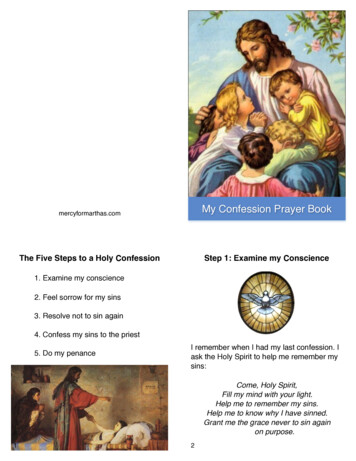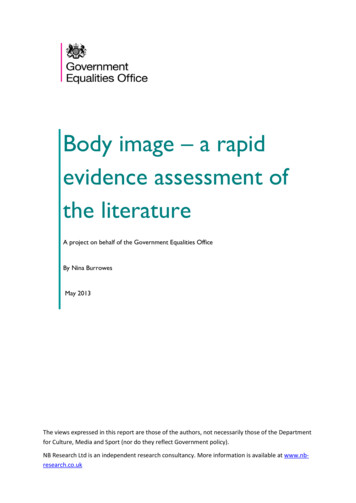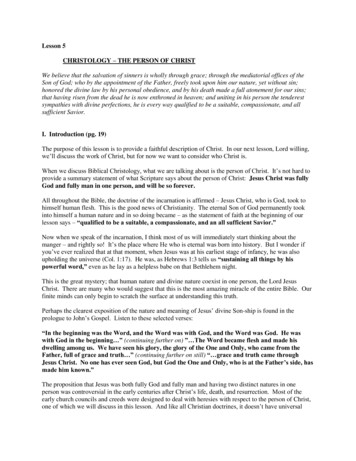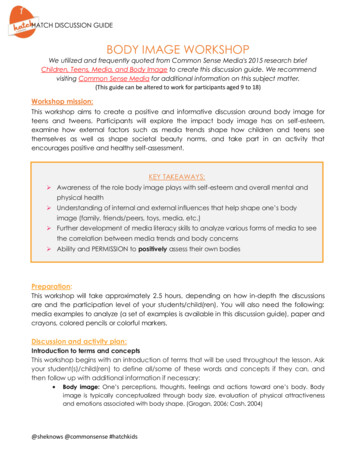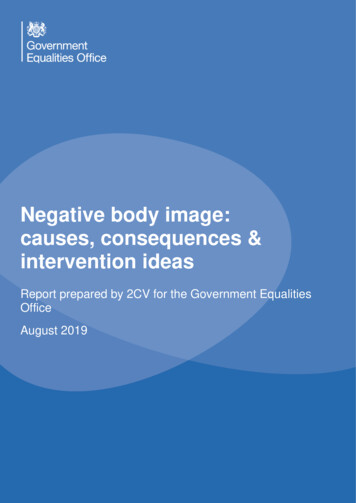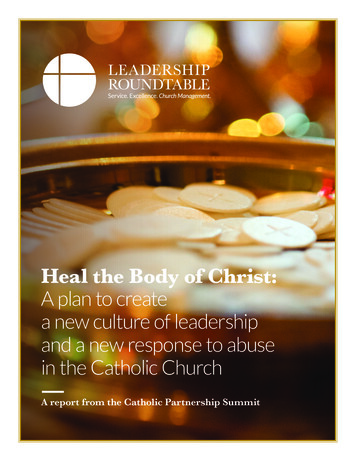
Transcription
Heal the Body of Christ:A plan to createa new culture of leadershipand a new response to abusein the Catholic ChurchA report from the Catholic Partnership Summit
OUR MISSIONLeadership Roundtable promotes best practices and accountabilityin the management, finances, communications, and humanresources development of the Catholic Church in the U.S., includinggreater incorporation of the expertise of the laity.
Table of ContentsIntroductionpage 3Guiding Principles, Desired Outcomes, Key Conceptsto Respond to the Twin Crises of Abuse and Leadership Failurespage 4Identifying the Root Causes of the Twin Crises and the Culture ChangeNeeded to Address Thempage 5Creating a New Culture of Leadershippage 9Creating a New Culture of Responding to Sexual Abusepage 19Task Forces: An Architecture for Recovery and Reformpage 29Leadership Roundtable’s Next Stepspage 32List of Expert Contributorspage 361
2
Dear Friend,The body of Christ has been gravely wounded.Catholics throughout the United States, and across theglobe, have felt the impact of twin crises: the crisis ofsexual abuse and the crisis of leadership failures thatcovered up the abuse.Sexual abuse survivors have been the ones mostdeeply affected. Additionally, as scripture reminds us,“if one member suffers, all suffer together with it”(1 Corinthians 12:26). Friends and families,parishioners, and ministers have also felt the impact.Therefore, as lay, religious, and ordained Catholics,each of us needs to be part of the solution towardsrecovery and reform.United, we must address the root causes, as wellas promote a new culture of leadership and a newresponse to abuse. The underlying conditions creatingthese crises were decades in the making; solving theseproblems will require a long-term, culture change thatmust begin with immediate steps, putting survivors first.Since the crises broke in the summer of 2018, morethan 50 dioceses have reached out to LeadershipRoundtable for help. In February 2019, we convenedthe Catholic Partnership Summit with more than200 Catholic leaders. The attendees hailed from 43dioceses and included bishops and abuse survivors,diocesan staff and college presidents, corporate leadersand theologians, canon lawyers and philanthropists,religious superiors and experts in abuse prevention.The Summit identified best practices in bishopaccountability and co-responsibility, as well as bestpractices for responding to sexual abuse. The toprecommendations from these discussions were sentto U.S. representatives attending the Vatican meetingon abuse and are are published in this report. Therecommendations are grouped into accountability, coresponsibility, and transparency, to align with the threeareas addressed during the Vatican meeting. Specificrecommendations are identified for the USCCBleadership, bishops, and lay leaders.We call upon Catholic leaders and thewider Catholic community in the UnitedStates to give serious reflection to theserecommendations, to share them broadly,and to commit to implementing themlocally and nationally.Leadership Roundtable seeks to provide a path towardsrecovery and reform for the Catholic Church in theUnited States. We trust that God is with our Churchas we commit to healing for abuse survivors and to atransformation of the leadership culture so that thepeople of God may flourish again.Kim Smolik, Ed.D.Chief Executive Officer3
Guiding Principles, Desired Outcomes,Key Concepts to Respond to the Twin Crisesof Abuse and Leadership FailuresIn speaking with bishops and experts, Leadership Roundtable developed these guiding principles to helpshape recommendations to address the twin crises at a diocesan or national level.Guiding Principles impact the Catholic Church based on five principles: transparency, accountability, competency,justice, and trust, impact the leadership and management culture of the Church, in line with Catholic beliefs, ecclesiology,and canon law, restore trust in the Church based on measurable, visible outcomes, engage both ordained and lay Catholics, working together for the mission, lean forward, not dwell in the past; be realistic and able to be translated into practical strategy, organization, and implementation.Desired Outcomes1. Model the clergy-lay collaboration and co-responsibility that is the future of our Church2. Develop actionable recommendations for USCCB leadership3. Develop actionable recommendations for bishops and disseminate as best practices throughout the country4. Begin to focus on root causes of the crisisKey ConceptsThe following concepts capture the heart of the dialogue at the Catholic Partnership Summit. Therewas a recognition that: there are twin crises that need twin solutions silence is no longer an option; there is an urgentneed for bishops to act now, at the heart of all abuse, is an abuse of power, we should not conflate authority and power, there has been a failure to call clergy toaccountability, everyone needs to be at the table, a diverse rangeof clergy and laity, including bishops and religious,mothers and fathers,4 any reforms need to address both the heart andmind: there is a need for moral integrity andspiritual conversion, as well as procedural andstructural change, synodality is a necessary characteristic of theresponse; the results of reform will not only address theabuse and leadership failures, but will help themission of the Church to thrive.
Identifying the Root Causes ofthe Twin Crises and the Culture ChangeNeeded to Address ThemThis section contains a summary of the expert input and discussion during theCatholic Partnership Summit concerning the root causes of the twin crises. It concludeswith a list of root causes and recommendations for deepening the understanding of them.Horrific as the sexual abuse andthe twin crises: the crisis of sexualbefore an audience of more thanleadership crises confronting theabuse and the crisis of leadership200 Catholic leaders.Catholic Church in the Unitedfailures that covered up that abuse.States has been, there is anLeadership Roundtable’s Catholicabiding hope that from its ashesPartnership Summit, held Februarycan emerge a bold new culture of1 and 2 in Washington, D.C., wasleadership and management thatan important step on the road tocombines the abundant strengthsidentifying the foundational andof clergy and laity to ensuresystemic causes of the crises alongtransparency, accountability, andwith meaningful and sustainableco-responsibility. The new cultureways to address them. “This is ashould not only provide safety forwatershed moment in which weall ages, but also renew the Churchhave to look at how we exerciseand restore trust.leadership in the life of the ChurchTo be successful, this rebuildingfirst requires a meticulousassessment of the root causes ofand authority in the life of theKim Daniels, Associate Directorof the Initiative on CatholicSocial Thought and Public Life atGeorgetown University, spoke tothe urgent need to take action. Shetalked about a recent gatheringwith young Catholics in which shewas reminded that “it’s on us.tohelp carry forward the deposit offaith for them.”Identifying the Root CausesChurch,” said Cardinal BlaseThe Catholic Church hasCupich, Archbishop of Chicago,historically operated with anSilence is not an option for any of us.–JOH N C A R R5
This is a watershed moment in which we have to look at how we exercise leadershipin the life of the Church and authority in the life of the Church.– C A R DI N A L BL A SE C U P IC Hinsular form of governance. WithinCardinal Tobin went on to speakuses his position in the Church forthe diocesan structure, decisions areabout the need for all the baptizedpersonal gain. Among its forms aremade by bishops with little inputto be part of the solution to thea pastor who makes an importantfrom others beyond the chancery.crises. “We’re certainly looking todecision for the parish withoutSynodality and communicationother people to help us.”proper consultation, or a bishopamong bishops and with othersare at best limited. “It’s a toxiccondition because bishops canbecome individually isolated—and isolated first and foremostfrom each other,” acknowledgedCardinal Joseph Tobin, Archbishopof Newark. “And when thathappens, it’s difficult to call eachother to accountability.” What’smore, there are not structures inplace to ensure Church leader hearwith candor the needs or expertiseof the laity, let alone the anguishand righteous anger of thosewho have been sexually abused,their families, and communities.Kim Daniels6Without being in touch and hearingfrom others, a pernicious cultureof clericalism results in a mentalityand actions in which clergy seethemselves as separate from otherwho opts not to be transparentabout a matter involving sexualabuse in the Church and attemptsto minimize its traumatic effects onvictims.Catholics and put themselves or theIndeed, the twin crises hasinstitution ahead of the wellbeingdemonstrated to many thatof the faithful. Clericalism issilence is no longer an option, andseen by many as pervasive in thethat the strategy most urgentlyChurch today and Pope Francisneeded today is transparency, tohas asked Catholics to purge it intell the truth freely and openly.all its forms. In an article by BishopThat point was driven homeShawn McKnight of the Diocesepoignantly by John Carr, founderof Jefferson City, MO clericalismand director of the Initiative onoccurs when a member of the clergyCatholic Social Thought and Public– be it bishop, priest, or deacon –Life at Georgetown University.Cardinal Blase Cupich, Cardinal Joseph Tobin,Cardinal Seán Patrick O’Malley
to come to the surface. I think it’sreally important for us to movein that direction and to realize.there are experiences that ordinarypeople have in their daily lives thatcan help us. So we shouldn’t bewriting documents on healthcare,war and peace, racism, and humansexuality without having broadconversations with people aboutJohn Carr, Kerry Robinson, Kim Smoliktheir own experiences, because wedon’t have those experiences.”A one-time seminarian andco-responsibility are the necessarysurvivor of clergy abuse who haspathways forward. Not only areThere is no underestimating thediscussed the subject publicly andnew structures needed to moverole and expertise of the laity,in intense dialogues with students,bishops beyond their isolation andas well as the importance ofCarr noted, “Silence is not anunilateral decision-making, buttransparency, accountability, andoption for any of us. While it mayto improve the relationship andco-responsibility to a new culture ofbe true that children are more safecommunications between bishops,servant leadership and managementin the Catholic community becausepriests, and laity.for the Church. Cardinal Seánof the protections that have beenput in place.it is also true that theepiscopal culture, the secrecy thatallowed, abetted, aided, enabled(the abuse crisis) is still in place intoo many ways.”Transforming the CultureCardinal Cupich explained PopeFrancis’ vision for this foundationalchange: inverting the currentorganizational pyramid that keepsa bishop isolated at the top. Instead,the exercise of authority shouldbe about building a capacity forparticipation and involvement ofMany of the clergy and laity at theCatholics from all walks of life whoSummit believed that clericalismare willing to apply their gifts andand a lack of transparency,skills to the benefit of the Church.accountability, and co-responsibleThe Holy Father has pointed to thegovernance are among the rootconcept of “synodality” as a waycauses of the Church’s currentto transform the culture. Cardinalplight. Many felt, therefore, that aCupich elaborated that leadersnew culture that addresses theseshould “not see ourselves as servingroot causes and provides moreby governing, but governing bytransparency, accountability andserving, and allowing people’s giftsO’Malley perhaps said it best forSummit attendees by describing thechallenge he faced on being namedArchbishop of Boston in 2003, at atime of economic troubles triggeredby the sexual abuse crisis within thearchdiocese. “It was only because ofthe lay advisory groups that cametogether that we have been able torecover from that,” he declared.“And one of the things that weembraced coming out of this wastransparency.” It is due to clergyand laity working together, thatthey have begun to make significantstrides towards recovery and reform.7
Root Causes of Twin CrisesThe following root causes need to be addressed in order to effectculture change in the Church1. Lack of Bishop Accountability2. Lack of Co-Responsible Governance Structures and Need for Synodality3. Lack of Transparency4. ClericalismNext steps to deepen the understanding of root causesAs additional root causes become apparent, they should be studied further and a clear action plandeveloped.1. Conduct objective, systematic study of root causes of the crises to ensure the Church isaddressing foundational issues and not just their symptoms; leverage the expertise of academicinstitutions and theologians2. Define clericalism, its root causes, and the various forms it takes3. Consider how seminary culture and curriculum contribute to a culture of clericalism4. Commission research and update the John Jay study to reflect the most recent data5. Do a gap analysis to identify current culture and utilize a culture transformation model to helparticulate and implement the desired culture8
Creating a New Cultureof LeadershipThis section contains a summary of the expert input and discussion during the Catholic PartnershipSummit about how to reform the leadership culture that covered up the abuse, as well as the actionsnecessary to produce a new culture of servant leadership and management. It concludes withrecommendations from the Summit for improving accountability, co-responsibility, and transparencywithin the new culture.From the discussions amongonce-redoubtable religious, moral,more than one speaker pointed out,Catholic Church leaders at theand intellectual authority.organizations that have accountablesecond session of LeadershipRoundtable’s Catholic PartnershipSummit, this sobering theme arose:the problems facing the Church areabout more than sexual abuse. TheChurch is also facing the blatantabuse of power at the leadershiplevel that has damaged the Church’sThat recognition was part of anintense examination of bishopaccountability, clergy-laity co-leaders have trusted leaders – andthat’s a highly desirable place forthe Church to move toward.responsibility, and the role layFor Fr. Bryan Hehir, Secretaryand ordained leaders may play infor Health and Social Servicesmoving the Church from a shamefulin the Archdiocese of Boston,recent past to a hopeful future. Asresponsibility provides the moralBishop Shawn McKnight, Barbara Anne Cusack9
This has to be a complete response by the Church, not just part,but all of us have to be engaged and proactive.– BI SHOPSH AW N MC K N IGH Tfoundation for accountability, andsharing and use of power, includingworked to resolve more than 200“accountability is the public facethe laity. “The question is how isknown cases of sexual abuseof those who take responsibility,”[power] applied.how do we applyof children.he noted. In practice, responsibilitythe checks and balances that areencompasses ownership forbest practices in the corporatethe tasks we are charged withworld, how can they be applied alsodoing. Accountability is takingto how we live as a Church andresponsibility for one’s actions andhow we function as a Church,”performance.he explained.What does the lack of accountabilityand co-responsibility look like withinthe Church? Chancellor BarbaraThe Need for New Structuresin Bishop AccountabilityAt its Fall General Assemblyin November 2018, the UnitedStates Conference of CatholicBishops (USCCB) called for thedevelopment of new protocols inresponse to the sexual abuse andleadership crises. These included acode of conduct for bishops and anindependent commission to addressallegations of abuse against bishops.Anne Cusack of the Archdiocese ofThe Summit also addressed theMilwaukee noted that if there arequestion of how the Catholiconly mitres and collars sitting aroundChurch could build a system ofReforms for Leadershipthe table making decisions, thenaccountability and co-responsibilityCulture Changethere are no mothers, fathers, orthat could provide checks andother lay people.balances for the everyday actions of“It’s clear that the Catholic Churchhas no real system of accountabilitybecause there are no sanctions for apriest once he’s ordained, except ifhe abuses money, children, or powerin an extreme way,” commentedFr. Hans Zollner, President of theCentre for Child Protection of thePontifical Gregorian Universityin Rome. He went on to defineaccountability as the collective10bishops and other Church leaders.“I suggest it’s multiple layers ofcodes of conduct, a procedurefor how a complaint would getheard, an allegation would getinvestigated, and then a processfor determining what kind ofconsequence would follow,” offeredBrian Reynolds, Chancellor andChief Administrative Officer for theArchdiocese of Louisville, who hasBishop Shawn McKnight of theDiocese of Jefferson City spokeabout how he felt the need for“sober, yet immediate action” as helistened to the people of his diocesein the wake of the recent crises. Hecreated a protocol should there bean allegation against a sitting bishopof his diocese. He also required thereligious communities serving in hisdiocese to commit to releasing thenames of those credibly accused intheir communities in order to serve
within the diocese. “This has to be aculture. “We need more concretetake place.” He added that leaderscomplete response by the Church,”and clear uses of penal law,” shealso need to put a priority on talkingaffirmed Bishop McKnight, “notcontended, “and bishops have towith those who are survivors andjust part, but all of us have to behold one another accountable.”those who are abusers. “We needengaged and proactive.”Clearly, accountability and co-to understand that the abusers andthe survivors are human beings, realThe role of canon law, as a scaffoldresponsibility cannot hope tofor strengthening accountabilitythrive within the Church in theand co-responsibility, cameabsence of transparency or goodunder scrutiny at the two-daycommunication, multiple speakersDespite the recognition that someSummit. The consensus was thatasserted. With regards to whatproposals will take time to change,the Code of Canon Law needseffective communication looksthere was a widespread belief thatsignificant updating to turn itlike in the Church, it is oftensome reforms could – and should –into an effective platform for“inadequate, it’s poor, or actuallybe instituted without delay.leadership accountability. Barbarait’s nonexistent,” said Reynolds. HeAnne Cusack, Chancellor of theshared that the Church needs “moreArchdiocese of Milwaukee andspecific efforts at training thosea canon lawyer, believes that anyresponsible for communication, aschanges in canon law must followwell as the leadership.and a greaterfundamental changes in Churchrequirement that communicationlive people, we can’t just talk aboutthem as some third parties.”Brian Reynolds, Fr. Bryan Hehir11
Creating a New Culture of LeadershipFor USCCB LeadershipAccountabilityThere has been a failure to call bishops to accountability. There is a need for leadership development and support.1. Identify the twin crises as the main priority for Church funding and resourcing for the immediate future1.1 Commit to a preferential option for abuse victims and families, make it a priority to meet withsurvivors; keep survivors, families, and affected parishioners at all levels of decision-making1.2 Publicly and collectively acknowledge the leadership failure and cover-up2. Create structures to ensure a new culture of accountability2.1 Implement a Code of Conduct for bishops and ensure the Charter for the Protection of Children andYoung People includes bishops; consider a national working group of clergy and lay experts tohelp write these2.2 Create ministerial codes of conduct that recognize abuse of power not only against children,but also adults2.3 Commit to a framework for action with appropriate structures to address the multi-layered crisis;provide consultative groups the authority they need to do their work effectively2.4 Commit to and invest in creating a new culture of leadership and management that is transparent,accountable, and proactive in including lay leadership and co-responsibility2.5 Seek authority for the bishops conference to modify canon law to address local realities and updatecanon law to include a detailed list of punishments for clearly defined crimes of abuse or cover-upby clergy, religious, or laity2.6 Implement ongoing professional and personal formation, as well as 360-degree assessments forbishops and all Catholic leaders that begin in seminaries and ministerial programs; assessmentsshould be linked to appointments2.7 Require best practices in human resources: effective selection, training, assignment, evaluation,compensation, and continuing education2.8 Provide vocation directors with better training and develop national standards relating to clergyselection and abuse prevention2.9 Make the bishop selection process more transparent, utilizing a genuine discernment process thatincludes laity and clergy and takes into consideration the potential bishop’s experience in dealingwith abuse2.10 Consult with other denominations to learn about their processes of bishop accountability andco-responsibility12
3. Implement stronger formation programs for bishops and clergy3.1 Explore different models of training for new bishops3.2 Develop a mentoring system for bishops3.3 Revise the Plan for Priestly Formation and seminary curriculum to address the root causes ofclericalism by equipping priests with skills in shared leadership, transparency, and accountability3.4 Rethink models of seminary formation to address disparities between institutions3.5 Revise the theology of priesthood and priestly identity to reflect servant leadershipCo-responsibilityLaity and clergy are co-responsible in leadership in the Church. Synodality is a necessary characteristic of the response.1. Put in place mechanisms for greater synodality among bishops, among bishops and priests, amongclergy and laity2. Create a governance structure that is transparent with layered checks, balances, and oversight, andincludes the expertise of the laity at the parish, diocesan, and national level3. Ensure co-responsibility of lay and ordained in Church leadership and management through hiringappropriate and competent diverse lay personnel at all levels4. Develop and invest in ongoing formation programs in management and leadership to train clergy,religious, and laity, including bishops5. Involve women in initial and ongoing clergy formationTransparencySilence is no longer an option; there is an urgent need to act now and demonstrate transparent leadership.1. Provide consistent, transparent, and coordinated communications at all levels2. Invest in and train pastoral leaders in effective communications3. Establish a crisis communications plan for the USCCB and develop a proactive plan for restoring trust13
Creating a New Culture of LeadershipFor BishopsAccountabilityThere has been a failure to call bishops to accountability. There is a need for leadership development and support.1. Identify the twin crises as the main priority for Church funding and resourcing for the immediate future1.1 Commit to a preferential option for abuse victims and families, make it a priority to meet withsurvivors; keep survivors, families, and affected parishioners at all levels of decision-making1.2 Publicly acknowledge the leadership failure and cover-up2. Implement accountability structures for bishops and all Church leaders2.1 Create ministerial codes of conduct that include the bishop and that recognize abuse of power notonly against children, but also adults2.2 Commit to and invest in creating a new culture of leadership and management that is transparent,accountable, and proactive in including lay leadership and co-responsibility2.3 Require best practices in human resources: effective selection, training, assignment, evaluation,compensation, and continuing education2.4 Follow the example of bishops who have proactively set up their own accountability structures2.5 Implement ongoing professional and personal formation, as well as 360-degree assessments forbishops and all Catholic leaders that begin in seminaries and ministerial programs; assessmentsshould be linked to appointments2.6 Develop a mentoring system for bishops3. Explore new ways to ensure the bishop selection and succession process is accountable to the people3.1 Make the bishop selection process more transparent, utilizing a genuine discernment process thatincludes laity and clergy and takes into consideration the potential bishop’s experience in dealingwith abuse3.2 Implement a process of succession planning to manage bishop and senior diocesan leadershiptransitions14
Co-responsibilityLaity and clergy are co-responsible in leadership in the Church. Synodality is a necessary characteristic of the response.1. Do a gap analysis for identifying current culture and utilizing a culture transformation model to helpticulate and implement the desired culturear-2. Commit to a framework for action with appropriate structures to address the multi-layered crisis; provideconsultative groups the authority they need to do their work effectively2.1 Commit to a diocesan governance structure that is transparent with layered checks, balances,and oversight, including a strong presbyteral council, corporate board, and diocesan pastoral andfinance councils2.2 Ensure co-responsibility of lay and ordained in Church leadership and management throughrenewed structures and hiring appropriate and competent diverse lay personnel at the diocesan level2.3 Develop and invest in ongoing formation programs in management and leadership to train clergy,religious, and laity, including bishops2.4 Engage laity, including women, on personnel boards for clergy2.5 Put in place mechanisms for greater synodality among bishops, among bishops and priests, amongclergy and laity2.6 Develop a human resource system that can support Church leaders who are experiencingchallenges not connected to abuse3. Implement diocesan systems to involve laity in leadership3.1 Involve women in initial and ongoing clergy formation3.2 Explore alternative forms of parish leadership, including lay parish life coordinatorsTransparencySilence is no longer an option; there is an urgent need to act now and demonstrate transparent leadership.1. Provide consistent, transparent, and coordinated communications at all levels1.1 Invest in and train pastoral leaders in effective communications1.2 Establish a crisis communications plan and develop a proactive plan for restoring trust1.3 Identify best practices for bishops to listen to and engage parishioners that makes bishopsaccessible and responsive to needs2. Build a broad, deep, and transparent financial management and accounting system15
Creating a New Culture of LeadershipFor Lay LeadersAccountabilityLaity need to be involved in order to create a culture of accountability for all Church leaders.1. Diocesan leaders, parish leaders, and other lay experts need to be involved in creating a culture ofaccountability.1.1 Commit to a preferential option for abuse victims and families, make it a priority to meet withsurvivors; keep survivors, families, and affected parishioners at all levels of decision-making1.2 Identify the twin crises as the main priority for Church funding and resourcing for the immediatefuture1.3 Commit to and invest in creating a new culture of leadership and management that is transparent,accountable, and proactive in including lay leadership and co-responsibility1.4 Make the bishop selection process more transparent, utilizing a genuine discernment process thatincludes laity and clergy and takes into consideration the potential bishop’s experience in dealingwith abuse1.5 Implement a process of succession planning to manage bishop and senior diocesan leadershiptransitions1.6 Implement ongoing professional and personal formation, as well as 360-degree assessments for allCatholic leaders; assessments should be linked to ongoing formation requirements and ministryappointments1.7 Require best practices in human resources: effective selection, training, assignment, evaluation,compensation, and continuing education2. Theologians, canon lawyers, and other Catholic academics need to be involved in creating a culture ofaccountability.2.1 Revise the theology of priesthood and priestly identity to reflect servant Leadership2.2 Seek authority for the bishops conference to modify canon law to address local realities and updatecanon law to include a detailed list of punishments for clearly defined crimes of abuse or cover-upby clergy, religious, or laity3. Philanthropists need to be involved in creating a culture of accountability.3.1 Help the culture shift by requiring Catholic organizations seeking funding to adhere to standardsfor excellence in management and leadership16
Co-responsibilityLaity and clergy are co-responsible in leadership in the Church. Synodality is a necessary characteristic of the response.1. Diocesan leaders, parish leaders, and other lay experts need to be involved in creating a culture ofco-responsibility.1.1 Put in place mechanisms for greater synodality among bishops and priests, among clergy and laity,including diocesan synods, diocesan pastoral councils, vicariate/deanery councils, etc.1.2 Create or renew a governance structure that is transparent with layered checks, balances, andoversight, including a strong presbyteral cou
Kim Daniels Cardinal Blase Cupich, Cardinal Joseph Tobin,Cardinal Seán Patrick O’Malley. A one-time seminarian and survivor of clergy abuse who has discussed the subject publicly and in intense dialogues with students, Carr not

